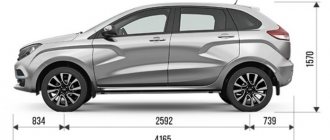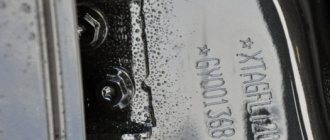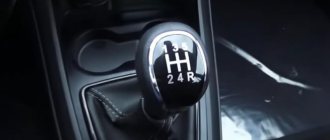Lada Vesta in the classic version
Vesta on methane
Station wagon Lada Vesta and Cross version
Lada Vesta Signature
Lada Vesta Sport
Since the fall of 2015, the Tolyatti concern has produced more than 70 thousand Lada Vesta sedans. The new product created a real sensation among fans of domestic cars. The updated design and modern approach to convenience and safety put the new model on a par with its closest competitors, such as Hyundai Solaris, Kia Rio, Ford Fiesta, Volkswagen Polo and others. But in order to firmly gain a foothold among the world's auto brands, AvtoVAZ plans to expand the Lada Vesta model range, adding new body types to it.
Popular sedan
Lada Vesta in a classic four-door design has already managed to win the popular love of Russian car enthusiasts. The modern appearance and generous equipment of the new product immediately attracted increased attention to the car. The sedan body combines the practicality of a family car, dynamism for young people and reliability for older people.
Lada Vesta in the classic version
On a note!
The dimensions of the sedan correspond to the dimensions of a class B car. The length of the body is 4410 mm, the width of the Lada Vesta is 1764 mm, and the height is 1497. The advantage of the sedan over many of its classmates is its significant ground clearance of 178 mm.
The configurations are presented in three main levels of equipment: Classic, Comfort and Luxury. Additionally, each version can be equipped with the Start, Image and Multimedia option packages. The basic Lada Vesta is already equipped with all the necessary security systems:
- ABS+BAS, ESC, TCS, EBD, HSA systems;
- two airbags;
- belts with pretensioners;
- ERA-GLONASS warning system;
- engine protection;
- immobilizer and alarm system.
The starting price for the Lada Vesta in the “base” is 545 thousand rubles. The maximum equipment of a car with a top-end engine and automatic transmission will cost 715 thousand rubles.
Lada Vesta - what kind of platform are you made of?
Lada Vesta, or rather its platform, was built initially on the basis of the Lada B, which in turn was a continuation of the Lada C platform (2006) - a joint project of AvtoVAZ and the Canadian one. This interesting platform had, in particular, a very beautiful design, high crash test scores (13 points out of 16 according to EuroNCAP), and a high drag coefficient (0.32). However, it did not go into production, and with the acquisition of part of the AvtoVAZ shares by the Renault-Nissan concern, as well as the arrival of Bo Andersson to the leadership, the platform began to be increasingly unified with Renault-Nissan products. If we clarify what platform the car is currently built on, we will see our own platform, based on the Lada B, but with a design developed by Steve Mattin for the LADA XRAY. Indeed, we see a lot of similarities in the design of both cars. Many elements of the Lada also have much in common with the cars of the Renault-Nissan concern. Which undoubtedly helps to unify the parts.
Bo Andersson, when he wondered what AvtoVAZ should build a new model on, quite logically decided that the Lada Vesta was a new car and platform that should be its own, and one that had been developed for a long time. The Lada B platform suited these parameters. It had a history of development since 2006. Which means it was well worked out. The Vesta project had a modern design and was supposed to make a splash, which it did, thanks to the design of Steve Mattin. Many successful developments of the Renault-Nissan concern have also found application where similar Russian ones did not meet the requirements of quality, reliability or manufacturability
People often ask, “Whose car has a larger component in the development of the platform - Russian or French-Japanese?” It is recognized by all that the serial Vesta has an original platform based on Russian developments.
The Vesta project provided for the further development of the platform. The Vesta concept also provided for the unification of parts with other models of the Renault concern - Nissan, and AvtoVAZ. Which was successfully achieved.
There are several Vesta bodies. In 2022, the sedan body was replenished with a station wagon. In the future there will be other body models. All bodies are galvanized on the outside, which is in contact with an aggressive environment. The body is galvanized with 6-year corrosion resistance (no Lada has ever been produced with such a guarantee before). The torsional rigidity of the body is also high. In terms of safety, Vesta received 4 points out of 5, thus ahead of even some foreign competitors. However, it must be taken into account that these tests were domestic in Russia and were carried out with cars produced in Russia, such as the Ford Focus and Renault. The final result should be expected from tests conducted by foreigners.
The Vesta sedan is distinguished by its elegant appearance and comfort. The station wagon made it possible to use the interior space of the car even more.
Many elements of the Lada Vesta are completely original. For example, the original L-shaped front suspension with steering knuckles. Some elements are borrowed from the Renault Megane - the steering, for example. What was new was a body with a subframe on which the engine is mounted; this had never been used on Ladas before. The rear suspension of the Vesta was copied from the Renault Megane.
The Lada Vesta has a wider track than others in its class - 1510 mm, which means it is more stable on the road, there is more space for the driver, especially for passengers in the rear seat, the wheel arches are more spread out, and the useful volume of the trunk is also increased. The increased wheelbase is 2635 mm, which is even longer than in the “C” class!, and Vesta competes with the class below!
The ground clearance is not small - 171 mm (at full load), which is very important for Russia and its roads.
Thanks to the large size of the car, the suspension was able to be made with a longer stroke - the front compression and rebound strokes are 82 and 88 mm, respectively, and the rear - 100 mm each.
So, we see that the basis of the body was the “LADA C”, but with numerous modifications, the rear suspension is very similar to the Renault Megane, the front suspension was developed from scratch, the steering is also almost identical to the Renault Megane.
The most important feature of the Lada Vesta is the noise and vibration reduction system; it was taken into account during the development of the body. As well as shock absorption elements in case of a frontal impact.
The design of the car provided anti-gravel protection along the entire lower surface of the body. Both the bottom and sills of the car have it. And the doors are designed in such a way as to prevent snow from getting inside the cabin when opening the door in winter.
A range of engines from 1.6 liters (106 hp) to 1.8 liters. (122 l.) with manual and automatic transmissions, as well as a robot.
An interesting variety is the Vesta with pre-installed gas equipment, which allows you to drive on both economical gas and gasoline.
In the near future, the manufacturer also promises a diesel engine developed by Renault-Nissan.
Serial Vesta pleases owners not only with its appearance, quality of parts, but also with price. They start from 594,900, and up to 824,400 rubles, in the maximum configuration. Of course, dealer prices vary.
The president of the auto concern also announced that after some time the LADA Vesta SW Cross would be released, and it came out. This model has the features of a crossover. Vesta SW Cross will have larger wheel sizes and ground clearance will be increased to 203 mm.
Vesta on methane
Vesta on methane Recently, the Lada Vesta model range was replenished with a new AvtoVAZ product that runs on two types of fuel - natural gas, methane and gasoline.
This universal development allows you to travel long distances without refueling and significantly save money on fuel. This Lada Vesta model is made on the same platform as a regular sedan. The engine and exhaust system have been modified. The gas cylinder is located in the luggage compartment. The gas filling tube is located under the hatch cover, next to the neck of the gas tank.
The engine starts on gasoline, and then the engine switches to methane. If the gas runs out, it automatically switches to gasoline. You can also independently switch the fuel supply from different tanks using a special switch.
The equipment of the newcomer to the AvtoVAZ model range corresponds to the same three trim levels as a regular sedan. The choice of engine and transmission is limited to one option: a 106-horsepower engine paired with a manual transmission. Prices for the gas version start from 600 thousand rubles and end at 715 thousand.
An excursion into the history of the creation of Lada Vesta
August 2014 became a significant milestone in the history of LADA Vesta.
It was at this time that the Moscow International Motor Show satisfied public interest and presented a concept car created in the Vercarmodel studio in Turin. At the request of AVTOVAZ, five more samples were made: one LADA Vesta WTCC concept, as well as two XRAY and LADA Vesta concepts each. Two concepts were needed due to the demonstration taking place at the same time in Togliatti. According to AVTOVAZ chief designer Steve Mattin, due to a lack of funds, production models will differ slightly from the presented samples. In the exhibition concept cars offered to the public, the most simplified filling is used, and with the help of various tricks the appearance is embellished.
Who owns the car interior?
The interior design of the LADA Vesta belongs to the talented Tolyatti designer Andrey Bessolitsin, who previously fruitfully worked on the updated Priora and Kalina-2. The control unit for the Vesta climate control system remains the same, from the VAZ.
Innovations include a multifunction steering wheel, instruments in so-called wells, seat upholstery in original material with colored decorative inserts.
The interiors of production cars will be almost identical, differing favorably from the interiors of models of previous years, and a person, once behind the wheel of a LADA Vesta, will, as they say, feel the difference.
The car that is planned to be launched into series and the LADA Vesta concept have similar dimensions. However, not a single production part can be found in the concept. Vesta is intended to become a replacement for Priora, the brainchild of the Lada B project, and will be in the middle of classes B and C.
The Lada Priora and the concept have the same length of 4.35 m, but the LADA Vesta has a wheelbase of 2.65 m, which is 15 cm longer than the Priora.
Julien Droir, who worked for eleven years at the Renault design center and won the competition for Vesta’s exterior, is responsible for the appearance of LADA Vesta. Later, as a more knowledgeable and experienced specialist, he was entrusted with the exterior of the LADA XRAY. Mattin and Drouard did not become participants in the project from the first days of its existence. Before this, the Togliatti team already had good developments of their own and alternative options in favor of the Niva and Renault.
About borrowing
Much of Project C formed the basis of the Vesta platform, but there were also many undeniably successful borrowings, which, by the way, included the rear suspension beam from Renault. Although the LADA Vesta was designed here in Russia, to create the concept it was decided to turn to the well-established Vercarmodel studio, whose designers have distinguished themselves over the past two years with such concepts as the Honda Civic Tourer Concept, Porsche Sport Turismo Concept, SsangYong SIV-I, Kia Provo , Changan CS95, Subaru Viziv Concept, Hyundai i-oniq.
Conclusion
Each concept car is based on completely original technology, based on the use of fake interior parts and body elements. To be specific, the concept is simply a foam plastic dummy mounted on a metal frame with wheels and a power plant in the form of an electric motor, a manual transmission and lead-acid batteries located in the free cavity of the engine box and under the luggage compartment.
Foam body parts are manufactured on five-axis machines according to three-dimensional drawings created using special computer programs.
The basis for creating the seats are seats from other cars, re-covered with foam rubber and covered with leather in order to give the desired shape and appearance.
The front panel consists of a plywood base and a modeling tape applied to it. They give, so to speak, a marketable appearance using a film similar in texture to the imitation material, leather or plastic. And only, perhaps, the glass and wheels can be called real. True, the wheels will also be upgraded. All excess is cut off from them, and then a new appearance is made from the model polymer.
When everything is ready, assembly, adjustment and finishing takes place. The result is so realistic that even an advanced motorist will have a hard time guessing that in front of him is just a mock-up that cannot make you enjoy either the noise of the engine or the intoxicating speed. Yes, this is not required. The purpose of concept cars is to arouse the interest of potential buyers, and we must assume that the LADA Vesta concept does this well.
Station wagon Lada Vesta and Cross version
Lada Vesta station wagon and Cross version Very soon the Lada Vesta model range will be replenished with a completely new version of the already beloved model.
The five-door body of the Lada Vesta will have the same X-shaped headlights and radiator grille, and the stampings on the doors and wings will remain. The rear of the car will change. The fifth door will have a larger glass area thanks to narrowed rear pillars. The sloping roof will be decorated with a radio antenna made in the shape of a fin. And a graceful spoiler will complete the look. In addition to the regular station wagon, the dimensions of which do not differ from the four-door version, the off-road Cross will appear in the Lada Vesta model range. The main difference between the Lada Vesta Cross and a simple station wagon will be the increased ground clearance of up to 190 mm and a plastic body kit throughout the body. Small updates will also affect the interior. Stylish colored inserts will appear in the front panel and on the doors of the car, and the seat trim will be updated with new combinations of materials and colors.
Interesting!
The Lada Vesta station wagon has been repeatedly spotted on public roads. The first production samples have already been delivered to car dealerships. Their sales will begin in early autumn 2022.
The final price for the five-door Lada Vesta model has not been announced. It is known that it will be 50-100 thousand rubles higher than the cost of the sedan. The price for the off-road version of Cross will be approximately 700-800 thousand rubles.
Specifications [ edit | edit code]
The length of the car exceeds the dimensions of the Priora and is 4.41 m (sedan and station wagon).
The car was created on the Lada B platform, a further processing of the unrealized Lada C project (2006). The design of the car is based on the LADA XRAY concept cars. It is reported that the car received a completely original front suspension with L-shaped arms and new steering knuckles and a 5-degree caster, and steering from Renault Megane. [6] The steering column is adjustable for tilt and reach on all trim levels. Some components, such as the brakes and radiator, are borrowed from Renault-Nissan designs.
The car is equipped with a 1.6 liter VAZ engine (106 hp VAZ-21129) and a 1.8 liter engine (122 hp VAZ-21179). Two transmission options are offered for the car. This is a 5-speed manual transmission and an automated manual transmission (AMT) of Russian design (VAZ 21827) [9]. You can find out which gearbox is on the car by the VIN number of the car: if it has the code GFL13, then the gearbox is Renault, if GFL11, the VAZ “mechanics” VAZ 21807 is installed. Versions with a “robot” have the code GFL12. [10] .
In 2022, LADA Vesta is planned to be equipped with gas-cylinder equipment, which will allow the use of natural gas (methane) compressed to 250 atmospheres as fuel. This version is equally capable of running on both regular gasoline and NG, which significantly expands the capabilities of the car. A pilot batch of gas-powered West and Largus cars of about 300 cars has already been produced (November 2015) and now [ when?
] is undergoing certification [11] .
Lada Vesta Signature
Lada Vesta Signature The longest car in the VAZ model range was the Signature version for VIP clients.
Initially, the model was developed to equip the fleet of state government agencies at the regional level. The emphasis was placed on comfortable placement of second-row passengers. Having received a body lengthening of 25 cm, the Lada Vesta Signature has remained almost unchanged in appearance. With the naked eye, you can distinguish it from a regular Vesta only from the side by the enlarged rear door. At the back of the car appeared the inscription “Signature”, made in the handwriting of Steve Mattin, the chief designer of the Lada Vesta. The design of the car remains the same. The long version will be equipped with a 122-horsepower engine. The suspension has received minor modifications.
The main changes affected the interior of the new product. The premium sedan of the VAZ model range received new interior finishing materials. Now the seats and steering wheel are trimmed with leather inserts, the ceiling is covered with Alcantara, and the rear sofa has turned into two separate luxurious armchairs, separated by a solid armrest. The climate control and heated seats for second-row passengers are controlled by buttons located on the armrest.
Interesting!
The very first long sedan was assembled for the former AvtoVAZ president Bo Andersson as an official vehicle.
The first samples of the extended version of the Lada Vesta were sent at the beginning of 2022 to the governments of the Samara and Moscow regions for testing and detection of possible deficiencies. According to preliminary data, the Signature version will be produced to order and cost about 1 million rubles.
Project development [edit | edit code]
The cost of developing the car was about 6.5 billion rubles. The first body of the pre-production Vesta was welded on November 5, 2014 in Izhevsk. On February 6, 2015, the first LADA Vesta body was welded and painted in Izhevsk using serial technology [4]. On September 25, 2015, a solemn ceremony took place to launch mass production of the model [5].
It was assumed that the sedan would go on sale first on November 25, 2015, then the hatchback [6], but later the plan was changed, and mass production of the station wagon and its off-road version began in 2022.
The Vesta sedan is offered to Russian buyers in three main trim levels. Initially, it was planned that the car would cost about 400 thousand rubles, but then AvtoVAZ President Bo Andersson decided to increase the cost to 500-550 thousand rubles [7]. On November 24, 2015, the final minimum price for the car was announced - 514 thousand rubles. As of December 2016, the price of a car starts from 529 thousand rubles. At the end of November 2022, the price of the car starts from 554,900 rubles.
On August 29, 2016, the head of AvtoVAZ, Nicolas More, said that the company abandoned plans to produce a hatchback due to possible intra-brand competition with the XRAY model [8]. On September 19, 2017, AvtoVAZ began accepting orders for Vesta SW and Vesta SW Cross station wagons.
On January 31, the LADA Vesta Sport appeared with a 1.8 liter engine producing 145 hp. With. This is the first Lada after 1998 worth more than 1 million rubles [ source not specified 90 days
] .
The release of a restyled model, Lada Vesta FL, is planned for the end of 2022 - beginning of 2022. In this configuration, Vesta will receive a completely new front panel, door cards and central floor tunnel. The interior of the car will also undergo changes - a huge multimedia system tablet will appear, with which the air conditioning unit is combined. Innovations will also affect the exterior of the car - new bumpers and radiator grille, plus a different design for the front optics and rear lights.
Lada Vesta Sport
Lada Vesta Sport The most sporty and powerful car in the model range of the Togliatti concern should be the Lada Vesta Sport.
The first sample was presented at the Moscow Motor Show in 2016. According to preliminary data, the sports car will be equipped with an engine developing 150 horsepower. The appearance will retain the X-shaped style of the Lada Vesta generation. A more aggressive design will appear, highlighted by bright color accents and a lower ground clearance of 135 mm. The release of the first civilian sports sedans is scheduled for the end of 2022. Their cost will be at least one million rubles.











